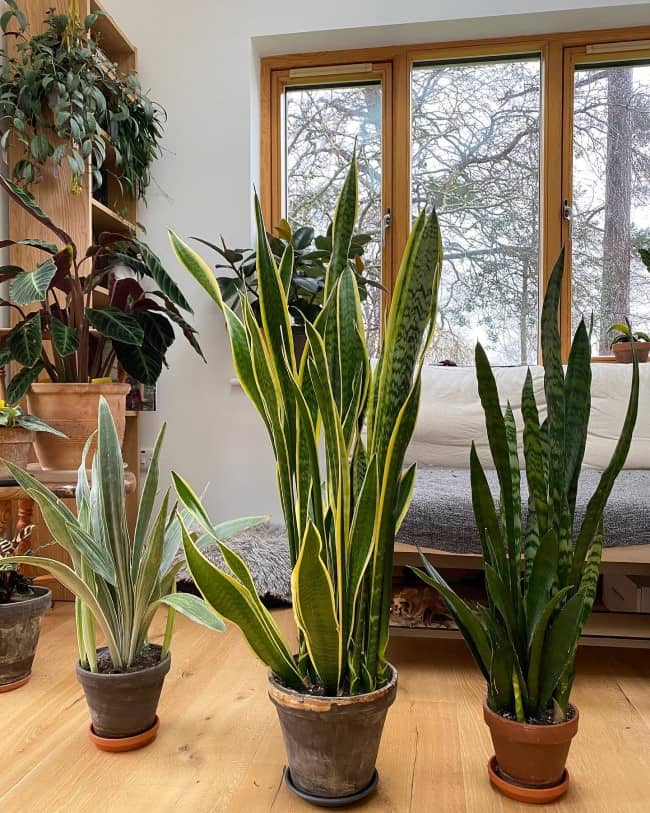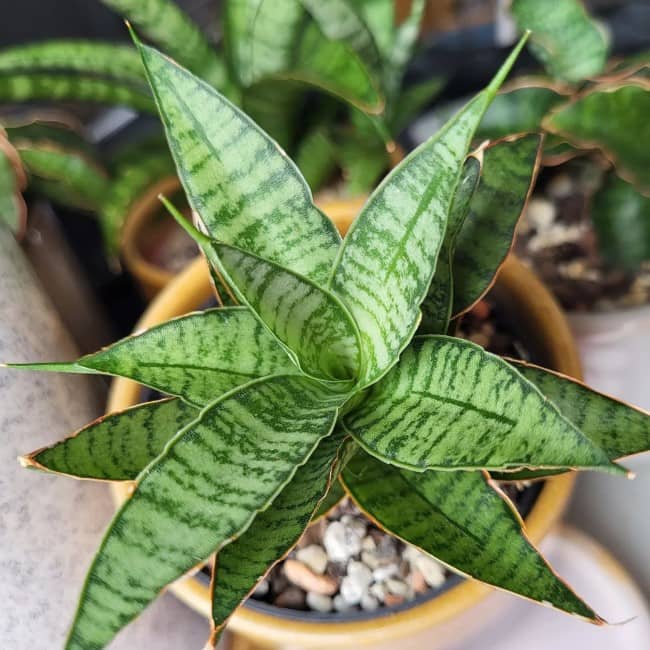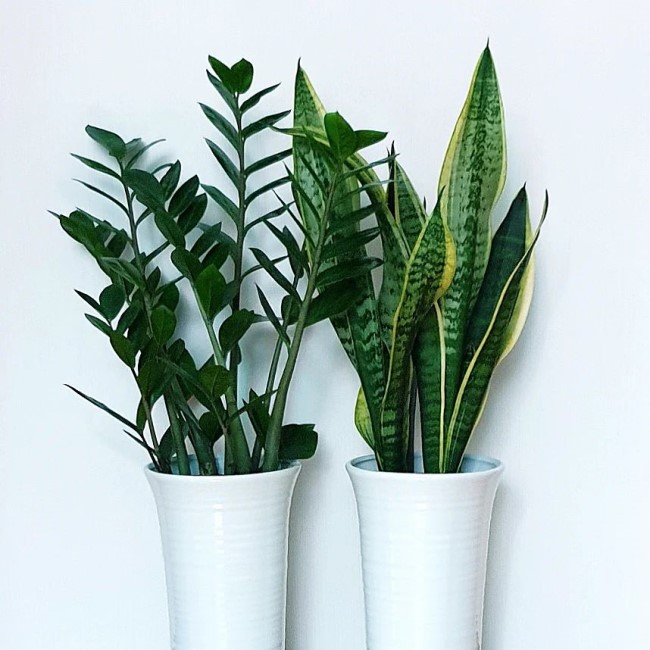
How to Care for Snake Plant
Also known as mother-in-law’s tongue due to its sharp, sword-like leaves, snake plants are, perhaps ironically, very uncomplicated, forgiving house plants that are generally easy to grow and care for.
Several varieties are available; on some, the leaves arch outward, others with white vertical stripes and yet more with yellow variegated edges. But they all have one thing in common – they are difficult to kill.
This makes snake plants ideal for new plant parents and those of us who love plants but don’t want to commit much time and effort to look after them.
Buy snake plant online at Gardeners Dream.
What is a Snake Plant?
Snake plants are succulents native to tropical western and southern Africa. They have tough foliage of tall upright leaves and are relatively slow growers. Snake plants tend to be unfussy and will tolerate a certain amount of neglect, so you don’t need much of a green thumb to keep them alive.
The botanical name for a snake plant is Sansevieria trifasciata. Common names include Viper’s Bowstring Hemp, St George’s Sword, and Bird’s Nest Fern.
Choosing a Location in the Home
With its hardy nature, Sansevieria trifasciata can grow well in most rooms in the house. However, there are some things to consider when choosing the perfect spot for your first snake plant.
How Much Light Does a Snake Plant Need?
Snake plants will thrive in almost any light conditions. They prefer a spot in bright indirect sunlight but cope well in low light, though the colour won’t be as vibrant as that of a plant placed in bright light. If the foliage starts looking leggy and droopy, moving the plant into brighter light – even a few hours of direct sunlight – will help get it back to looking its best.
Humidity
If you’re looking for a new plant for the kitchen or bathroom, a snake plant will certainly look good and tolerate the humidity. However, they flourish best in drier air and are better suited to areas like the bedroom or living room.
Temperature
Again, this isn’t a deal-breaker for snake plants. They do prefer a warm spot away from draughts but tolerate cooler rooms well. Whatever room you choose, ensure the temperature is relatively steady. When temperatures drop or rise too suddenly, the plant can go into shock.
Snake Plant Toxicity
Snake plants are relatively safe for humans but can be mildly toxic if eaten.
However, they contain saponins, which are poisonous to cats and dogs. If ingested, these toxins can cause vomiting and diarrhoea but touching the sap can also lead to skin irritation and swelling.
For this reason, always ensure snake plants are kept well out of your furry friend’s reach.
Caring for Snake Plants
As mentioned above, snake plants are low-maintenance, undemanding house plants. But, like all plants, they do require a little TLC to thrive.
Watering Snake Plants
Succulents store extra moisture in their thick leaves, so snake plants don’t need to be watered too often. The root ball does not like sitting in wet or moist soil for extended periods, so allow the soil to dry out completely between waterings. Water less often in autumn and winter since the plant isn’t working so hard outside of the growing season.
As a general rule, under-watering a snake plant is better than over-watering it. It is very easy to water a snake plant too much, resulting in root rot.
Snake Plant Soil Needs
As with most things, sansevieria trifasciata is quite easy-going with its soil needs. Except when it comes to moisture. Wet soil is a snake plant’s Achille’s heel. Therefore, a well-draining potting mix is best to help prevent root rot from developing. A potting soil designed for cacti and succulents is perfect.
Should I Mist My Snake Plant?
The short answer is no. Snake plants aren’t fond of humidity and don’t need to be misted regularly. In fact, they prefer not to be misted at all. (We did say this is a low-maintenance house plant!) A quick wipe with a damp cloth is plenty to keep the tall leaves free of dust.
Snake Plant Care Tips
- Use a pot heavy enough to stop the plant from toppling over. Terra cotta is ideal because it affords better drainage than a plastic pot.
- Don’t move a snake plant from low light to bright light too suddenly. Do it gradually, over a couple of weeks.
- Apply a quality liquid plant food 2-3 times a year during the growing season. This isn’t essential but will give your plant a boost.
- Replace the soil annually to help protect against root rot.
- With proper care a snake plant can live for up to 25 years.
Types of Snake Plant Problems
Pests and Problems
While snake plants are low-maintenance, easy-going house plants, you may sometimes run into an issue. Most problems you encounter will be easy enough to remedy with a little extra care and attention.
Root Rot
Root rot is the most common problem found in snake plants. It isn’t pleasant, and definitely isn’t good for the plant. However, most snake plants will bounce back if the problem is dealt with quickly.
If the leaves start turning yellow or the soil snake plants are planted in gets a bit whiffy, root rot is the likely cause. This is usually down to over-watering, but don’t panic, as it can be fixed.
The foul smell comes from the decomposition and rotting of the damaged root. Don’t give it more time to spread along the roots and prevent the plant from absorbing essential nutrients.
Step-By-Step Guide to Getting Rid of Root Rot
- Remove the plant from its pot and rinse excess soil from the roots.
- Use secateurs to cut the roots just above the rotten parts. Don’t leave any traces of damaged roots.
- Set the plant aside and leave it overnight for the wounds on the root system to form a callus.
- Clean the pot thoroughly and fill it with fresh, well-draining soil.
- Plant the snake plant, ensuring it is deep enough to stay upright and that the soil isn’t packed down too hard, allowing good air circulation.
- Water the plant ensuring excess moisture drains away freely.
Common Pests
Snake plants are generally pest-free but can succumb to aphids, spider mites, gnats or mealy bugs. The easiest way to prevent this is to keep the plant healthy – infestations usually happen when a snake plant is vulnerable due to over-watering, not receiving enough light or needing repotted.
Don’t underestimate how quickly a couple of tiny insects can turn onto a full-on infestation. Act quickly to protect the plant and isolate the affected snake plant to prevent the bugs from spreading to your other plants.
In the first instance, pick or wipe pests off the plant’s leaves and use yellow sticky traps to catch those you can’t see. If the problem persists, you may wish to use an insecticide to eradicate the problem.
How to Propagate Snake Plants
As well as being easy to care for, snake plants are simple to propagate, so you can share them with family and friends or have a houseful of your own in next to no time. The best time to propagate a snake plant is in spring or summer when the plant is actively growing.
Division
Division is a great way to propagate a larger snake plant. This method of propagation keeps the unique leaf markings and is recommended for a variegated snake plant. Other propagation methods will produce a mother-in-law’s tongue plant with plain dark green leaves.
Remove the plant from its pot and use a sharp knife to divide the root ball. Replant each new section in its own pot with moist cactus potting soil and water it well, ensuring excess moisture drains away. Place the plant in a bright spot out of the direct sun and continue your regular watering schedule.
Leaf Cuttings in Water
Rooting snake plants in water is extremely simple, but the new snake plant won’t be quite as tough as one propagated in soil.
Use sharp secateurs to cut off a mature leaf at the soil line. Place the leaf in a glass or vase of water, with the cut end submerged. Replace the water once a week and keep an eye out for new growth at the base of the leaf. Roots will begin to appear at the cut end of the leaf in 3-4 weeks. Leave the plant in water until they are around 2 inches long. Then plant the leaves in a clean pot with a well-draining potting mix. Water it well and keep it in a bright indirect light.
Leaf Cuttings in Soil
This method takes significantly longer than rooting leaves in water but it does result in a more resilient new plant.
Again, begin by using a sharp knife or secateurs to remove one of the narrow leaves from an established snake plant. Cut the leaf horizontally into 2-3 inch sections. Take a shallow pot or tray filled with moist, well-drained potting mix and push the leaf pieces about half an inch into the soil, ensuring each piece is placed the right way up. Keep the soil slightly moist and ensure it drains well after every watering.
After around 2 months, try gently pulling the leaf pieces out of the soil. If they come out very easily they’re not quite ready and need to be placed back in the soil for a while longer. However, if you feel some resistance, that’s a sign that root growth is going well and the leaf cuttings are ready to be potted on.
Repotting a Snake Plant
As a slow grower that prefers to be slightly pot-bound, a snake plant doesn’t need to be repotted very often. You’ll know it’s time for your snake plant to move into a new pot when the roots start poking through the drainage holes and/or the water runs straight through the soil with no resistance. This is a sign that the pot is overcrowded and the plant can’t absorb enough nutrients from the soil.
Repotting snake plants isn’t a difficult or strenuous task. Snake plant roots are strong, so choose a sturdy pot that won’t crack or break easily. Fill the new pot with fresh potting soil – a cacti potting mix is ideal. Remove the snake plant from the pot and gently brush old soil from the root ball. Place it in the new pot and top it up with soil, ensuring the snake plant will stay upright, but that the soil isn’t packed down too much. Water well, allowing excess water to drain freely and place the plant in a bright spot.
Pointed leaves, interesting leaf patterns and a tall, proud silhouette make snake plants an attractive option for any room in the home. Snake plant care is easy, and the fact they tolerate a certain amount of neglect makes them a popular choice for new (or lazy!) plant owners.



